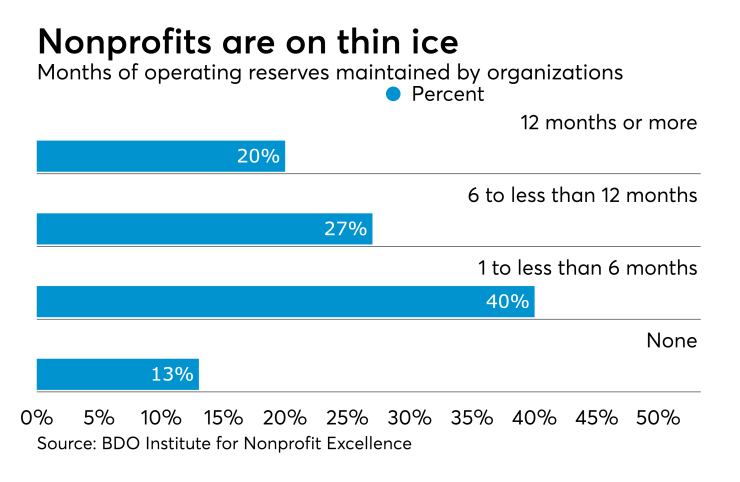Nonprofits are confronting a host of challenges, including the threat of spending cuts from the federal government that could severely tighten their budgets and ability to serve their communities.
A
“We know there is very often a balance in the nonprofit arena between having enough reserves to maintain stability and viability for the future, and be responsive to changes or disruptions within the industry, or things that affect the nonprofit organization,” said Laurie De Armond, a partner and national co-leader of BDO’s Nonprofit & Education Practice. “Reserves are extremely important, but that often gets balanced with the desire for the nonprofit to get as much money out for the actual programs that they’re running. What I think was concerning about the survey results is that a substantial number of organizations have less than 12 months, and 40 percent have between one and six months, of operating reserves available to them. The minimum I would say that organizations should have is six months.”

Either way, that may not be enough of a cushion in case of a sharp cutback in funds. “Many, I think, would prefer to have 12 months,” said De Armond. “The fact that so many have less than six months, and 13 percent had none, is indicative of a general problem within the industry about the ability to build up reserves, which would allow an organization to remain sustainable and viable through challenging economic times.”
Many of the nonprofits polled didn’t seem especially concerned about the lack of operating reserves, though the Financial Accounting Standards Board’s recently approved nonprofit standard will put more demands on organizations to demonstrate their liquidity. “Where the standard will come in is highlighting this challenge for nonprofit boards so that it will be more evident in the financial reporting that organizations have to do on an annual basis and allow for that conversation—at least annually through the audit process, but hopefully more often—to get boards to focus on trying to achieve stability for nonprofits, which will allow them to have sustainability into the future,” said De Armond.
For the survey, the BDO Institute for Nonprofit Excellence in partnership with The NonProfit Times and the market research firm Campbell Rinker polled 105 nonprofit organizations with annual revenue above $10 million.
Other findings were equally concerning. Only 3 percent of the organizations polled named fraud as a board concern, while only 9 percent maintain a fraud committee. However, 67 percent of the organizations surveyed have a whistleblower hotline, while 66 percent conduct an annual risk assessment.
Staffing and retention were cited most frequently as a challenge, mentioned by 72 percent of the poll respondents. In addition, 59 percent of the organizations said compensation is a key employee satisfaction issue, while 42 percent said their boards are concerned with succession planning.
“Staff retention and recruiting is something we consistently hear about,” said De Armond. “Very often nonprofits can’t afford to pay as much as for-profit organizations can, and often nonprofits have to be a little bit more creative with how they reward and compensate their employees. Many of the organizations provide flexible work schedules or allow employees to work remotely or telecommute. Those are ways that nonprofits have to be responsive to the fact that the salaries can’t necessarily be competitive with commercial enterprises.”
Liquidity Deficit
In anticipation of fears of spending cuts by the federal government, some organizations are already seeing their donors step forward with extra contributions.
“Cutbacks in funding and drops in revenue are very much top of mind for organizations that rely on federal funding,” said De Armond. “Anecdotally what we’re seeing with many of our clients is that some organizations, given what their missions are, are seeing an uptick in contributions by those in the general public that have concerns maybe about where the administration might go with the budget, particularly environmental organizations. Many of them are seeing an increase in funding. It’s the social service organizations that are extremely concerned, and some of the international organizations that provide international aid, relative to what will happen with the budget.”
The liquidity deficit is especially notable within health and human services organizations. Nearly one-quarter of them (23 percent) don’t maintain any operating reserves, compared to just 6 percent of public charities.
“The concern there is that if the government cuts back on spending needs, the need in the community for those services will increase while funding to those organizations will decrease, and there will be a gap in that sector’s ability to serve the communities that they support,” said De Armond. “Not having reserves makes it very challenging for organizations to financially sustain themselves and their programming when there are disruptions in their funding.”
Despite high-profile hacks of some nonprofits, only 18 percent of the organizations surveyed said cybersecurity is one of the top concerns for their board. “I was a bit shocked at that because when I meet with my clients at nonprofit boards, that is a question that comes up very frequently with nonprofit boards, as it should because it is an area of concern,” said De Armond. “I felt that number was quite low, but resource constraints are probably top of mind right now given the uncertainty right now with the government and some of the policies. But many of them understand the importance of it.”
Accountants can help their nonprofit clients by talking to the board members and management at the organization about the need to have sufficient liquidity and operating reserves. “For organizations that don’t have a sufficient safety net, conversations should be had to make sure the board is aware of that and what those risks are,” said De Armond. “That will have to come with decisions on the part of the board about what the right amount will be. From a budgeting perspective how can an organization budget to have surpluses sufficient to build up their operating reserves over time? Open, candid honest conversations about liquidity challenges are very important. The other thing is looking at the breakdown of revenue. Are they too dependent on one type of revenue stream? Are their revenue sources too reliant on one particular type of revenue stream so if there is a curtailment of that revenue stream, it would have a catastrophic impact on their ability to deliver services? Calling that out is something that accountants can do for their nonprofit clients, raising awareness so the board and management can work toward a plan for diversifying their revenue stream.”
Governance is also an important issue for boards, and making sure some of the members and trustees have some degree of financial and operational expertise. “Very often they’re made up of people that are very passionate about the mission, but not necessarily well versed in the operations of a nonprofit,” said De Armond. “Frequently we see that they are too heavily versed in people who are passionate about the mission and aren’t well rounded enough to really cover some of those elements of risk related to the operations of the board. Sometimes we see that the size of the board is way too big. Sometimes we also see that the number of board meetings a year is not sufficient. One of the findings is that 16 percent reported that they have fewer than four board meetings a year. How effective is your board being relative to their responsibilities if they’re meeting so infrequently? It could be that they’re delegating a lot of responsibility to the committees, but there’s risk with that. The questions were really designed to allow nonprofit organizations to compare themselves with their peers and look to see if they have the right composition of board members, the right number of board members, the right number of meetings a year, and what committee structure they have to begin to ask those questions and get a little bit more background into what other organizations are doing relative to best practices.”





